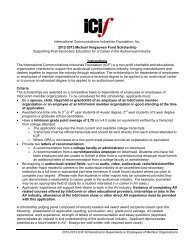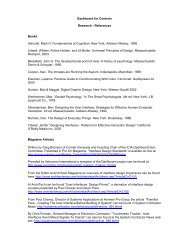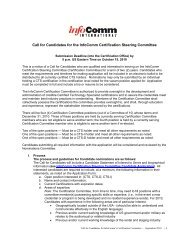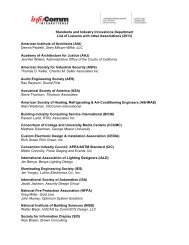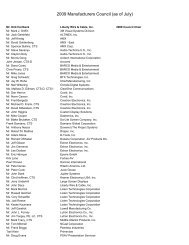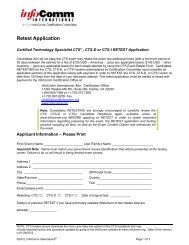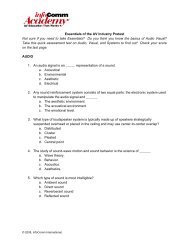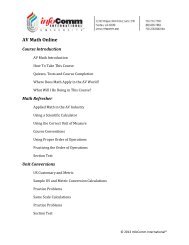Understanding Sound System Design and Feedback ... - InfoComm
Understanding Sound System Design and Feedback ... - InfoComm
Understanding Sound System Design and Feedback ... - InfoComm
You also want an ePaper? Increase the reach of your titles
YUMPU automatically turns print PDFs into web optimized ePapers that Google loves.
<strong>Underst<strong>and</strong>ing</strong> <strong>Sound</strong> <strong>System</strong> <strong>Design</strong><br />
<strong>and</strong> <strong>Feedback</strong> Using (Ugh!) Math<br />
by Rick Frank<br />
Shure Incorporated<br />
222 Hartrey Avenue<br />
Evanston, Illinois 60202-3696<br />
(847) 866-2200
<strong>Underst<strong>and</strong>ing</strong> <strong>Sound</strong> <strong>System</strong> <strong>Design</strong> <strong>and</strong> <strong>Feedback</strong><br />
Using (Ugh!) Math<br />
One of the basic building blocks of sound system design is the Potential Acoustic Gain (PAG) equation.<br />
With a few simple calculations it can provide a guide to dealing with the problems <strong>and</strong> restrictions<br />
encountered in this process.<br />
Here's a common situation confronting a sound contractor trying to provide a system for an existing room.<br />
He has a good working knowledge of the audio chain <strong>and</strong> the products at his disposal to assemble a<br />
"working system." He knows the room—let's say a conference room. And he knows where he (or the<br />
client) would like to place the microphones <strong>and</strong> speakers. But how can he know in advance whether the<br />
components he would like to install, <strong>and</strong> the layout he would like to use, will produce the gain needed<br />
without feedback? And for that matter, how much gain is needed?<br />
If he wants to do more than try what he "feels" should work <strong>and</strong> then hope for the best, he will pull out his<br />
calculator, plug in the dimensions of his system design, <strong>and</strong> let the equation guide him in the right<br />
direction.<br />
Unfortunately, many people who could benefit by underst<strong>and</strong>ing <strong>and</strong> using the equation are put off by its<br />
apparent complexity. This doesn't have to be the case as I will show in the following pages. A calculator<br />
with a "log" button <strong>and</strong> possibly a sound level meter are really all you need to take some of the mystery<br />
<strong>and</strong> potential disaster out of sound system design. It all starts with the Inverse Square Law.<br />
THE INVERSE SQUARE LAW—EASIER THAN IT SOUNDS<br />
Have you noticed that as you walk away from someone speaking, the talker's voice level decreases as<br />
perceived by your ears? What's happening is this: distance from a sound source affects the sound pressure<br />
level (SPL) on your ears in a particular way. It's described by the inverse square law which states that as<br />
listeners double their distance from the sound source, the SPL they perceive will decrease by 6.02dB. So<br />
if you first st<strong>and</strong> 4 feet from a talker <strong>and</strong> then move to a new position 8 feet from the talker, you should<br />
notice about a 6.02dB drop in level. (A one dB increase is barely audible, 3dB is a generally noticeable<br />
change, <strong>and</strong> a 10dB increase is considered to be twice as loud.) Mathematically the inverse square law<br />
looks like this:<br />
New Level = Old Level + 20 X log of old distance - 20 X log of new distance<br />
or in math shorth<strong>and</strong><br />
L' = L + 20 log D - 20 log D'<br />
This equation describes what happens in a so-called "free field." That means that there is no interference<br />
from things like reflected sounds <strong>and</strong> that the origin of the sound is a point source (a sound source which<br />
has much smaller dimensions than the distance to the listener). Since even the earth can complicate the<br />
issue, there is almost never a situation where we encounter the pure effects of this equation.<br />
That doesn't mean we have to ab<strong>and</strong>on the theory, but rather that we have to use it with the underst<strong>and</strong>ing<br />
that it will not perfectly predict what is going to happen when we apply it to a real situation. Because it's<br />
easier to underst<strong>and</strong> this way, let's try working through an example by assuming we're in a free field.
Using the previous example with the old distance, D, equal to 4 feet <strong>and</strong> the new distance, D' ("D prime"),<br />
equal to 8 feet, you can use your calculator to test this free space law. Let's say that the old level, L, of the<br />
talker measures 70dB at 4 feet. Incidentally, I've always found it is easiest to work in reverse on calculator<br />
logarithm (log) computations. So to work through the problem, punch the D' quantity "8" into the calculator,<br />
find the logarithm (hit the log button), <strong>and</strong> get 0.90309.<br />
Log of 8 = 0.90309<br />
Now multiply by 20 <strong>and</strong> get 18 (rounded from 18.0618). (Since 1dB is considered to be the smallest<br />
difference we can actually hear, I'll round all these figures to the nearest whole number.)<br />
0.90309 x 20 = 18 (rounded from 18.0618)<br />
Save this figure <strong>and</strong> punch in the old distance, D, of "4". If you follow the same steps the new answer is 12<br />
(again, rounded).<br />
log of 4 = 0.6021<br />
0.6021 x 20 = 12 (rounded from 12.0412)<br />
The final answer is just the arithmetic of the inverse square law: take the old sound pressure level of 70 plus<br />
12, minus 18, to arrive at the new level, 64 — 6dB less than the old level.<br />
New Level = Old Level + 20 X log of old distance - 20 X log of new distance<br />
64 = 70 + 12 - 18<br />
Because of the nature of logarithms <strong>and</strong> the inverse square law, this solution will occur with any pair of<br />
distances where one is twice the other. Let's say we move from 13 feet to 26 feet away from the talker.<br />
Working backwards again, entering 26 followed by the log button <strong>and</strong> multiplying by 20 gives 28dB<br />
(rounded). The same procedure with 13 gives 22dB. And the arithmetic (70 plus 22 minus 28) results in a<br />
level of 64dB — the same 6dB drop as we had with 4' to 8'.<br />
log of 13 = 1.1139434,<br />
1.1139434 x 20 = 22 (rounded from 22.278867),<br />
log of 26 = 1.4149733, 1.4149733 x 20 = 28<br />
New Level = Old Level + 20 X log of old distance - 20 X log of new distance<br />
64 = 70 + 22 - 28<br />
Of course this works in reverse, as your ears will tell you. If we move closer to the sound source by cutting<br />
the distance in half (from 8' to 4'), the sound level rises by 6dB. The important point to remember is that in<br />
order to get a significant 6dB sound level change, the distance must change by double or half.<br />
CRITICAL DISTANCE IS CRITICAL<br />
A lot of the limitations on the practical use of the inverse square law <strong>and</strong> the PAG equation have to do with<br />
what's called "critical distance." Basically, when the listener is within the critical distance of the source, the<br />
inverse square law works pretty well. Outside the critical distance things get much more complex.
The term "critical distance" is defined as the distance from a sound source where the direct sound is the<br />
same level as the reverberant sound. With a sound level meter <strong>and</strong> a de-tuned FM radio you can make a<br />
good estimate of critical distance in a room. The radio serves as a sound source to provide a constant,<br />
broad spectrum sound. If you walk backwards from the sound source with a sound level meter, you will<br />
reach a point where the level stops registering change on the meter. At that point, if you walk back<br />
towards the sound source until the meter increases exactly 3dB you will have reached the critical<br />
distance. (Equal sound from the direct source <strong>and</strong> the reverberant field add up to 3dB more than the<br />
reverberant sound alone.)<br />
Whether or not you actually make estimates of the critical distances within a system, there is one thing<br />
that is important to know. Typically in sound systems, the distance between the microphone <strong>and</strong> the<br />
talker is the only place where the system component receiver (the listener or microphone) is less than the<br />
critical distance from the source. Later when we look at the actual distances between the parts of a<br />
system, we'll see the dramatic effects of changing this distance.<br />
HOW MUCH ACOUSTIC GAIN IS NEEDED?<br />
With this in mind we're ready to look at the question of how much gain is needed for listeners in a given<br />
room. (Remember that in a real room the reflective surfaces create echoes <strong>and</strong> a reverberant field that<br />
interfere with the theoretical results of the inverse square law as well as the potential acoustic gain<br />
equation. This interference generally lowers the actual performance of a system.)<br />
Let's take an example of a conference room with a 22' table. Normal conversational level in a quiet room<br />
at a normal conversational distance of 2 feet is about 70dB. The inverse square law will tell us how much<br />
the loss will be if the listener is at the opposite end of the table, 22 feet away. That listener would ideally<br />
like to hear exactly what the close listener hears. The distance to the far listener creates the loss which the<br />
sound system should replace.<br />
Putting the figures from this scene into the inverse square law equation (using the mathematical shorth<strong>and</strong>)<br />
looks like this:<br />
L' = L + 20 log D - 20 log D'<br />
= 70 + 20 X log 2 - 20 X log 22<br />
Working backwards from the new distance, 22, punch in 22, take its log <strong>and</strong> multiply the result by 20. Write<br />
down that result (27), take the log of 2 the same way <strong>and</strong> multiply it by 20, <strong>and</strong> you get 6. Now the<br />
arithmetic: 70 plus 6 minus 27 equals 49 — telling us that the distant listener experiences a loss of 21dB (70<br />
- 49).<br />
L' = L + 20 log D - 20 log D'<br />
49 = 70 + 6 - 27<br />
49 = 70 - 21<br />
49 - 70 = -21 (a loss of 21dB)<br />
This is the sound system's target. The sound system must provide at least 21dB of gain for the farthest<br />
listener to hear the talker as if she is 2 feet away. This is called the needed acoustic gain (NAG). If the<br />
distant listener is supposed to hear as well as the near listener then the system must make up the 21dB<br />
loss caused by the distance.<br />
Of course if you have a sound level meter you can take a reading in both the near <strong>and</strong> far positions <strong>and</strong><br />
subtract to get to this point. But with the first method you get to underst<strong>and</strong> <strong>and</strong> see the inverse square law<br />
in action. It may also be interesting to compare the two answers to see how much the room acoustics affect<br />
the results that arc predicted by the inverse square law.
HOW MUCH ACOUSTIC GAIN CAN THE SYSTEM PRODUCE?<br />
Now let's work with the Potential Acoustic Gain equation to see if our system will theoretically produce<br />
the acoustic gain we need before it feeds back. To start we need to look at some of its individual terms.<br />
Each of these terms is a shorth<strong>and</strong> for a basic distance (D) in the sound system design, as illustrated in<br />
Figure 1. Since there are four significant distances between the elements in the system, each "D" has a<br />
subscript such as "D1", "DS", ("D sub one", "D sub S") etc. Specifically, this is what each term st<strong>and</strong>s for:<br />
Figure 1. The basic distances in a simple sound reinforcement system.<br />
"Electronic to Electronic" or "People to People" Distances<br />
D1 is the distance between the microphone <strong>and</strong> the loudspeaker<br />
(remember "1" as the first pan of the system).<br />
D0 is the distance between the talker <strong>and</strong> the farthest listener<br />
(remember "0" for observer).<br />
"People to Electronic" Distances<br />
D2 is the distance between the loudspeaker <strong>and</strong> the farthest listener<br />
(remember "2" as the last pan of the system).<br />
DS is the distance between the talker <strong>and</strong> the microphone<br />
(remember "S" for source).<br />
We now get to the point where we determine if the system can meet our need. This is where the Potential<br />
Acoustic Gain equation comes into play. The simplest form of this equation looks like this:<br />
PAG = 20 log D1 - 20 log D2 + 20 log D0 - 20 log DS<br />
This form of the equation will allow us to determine the amount of gain available from the system just<br />
before the undesirable oscillation we all know as feedback occurs. It also assumes the system uses<br />
omnidirectional microphones <strong>and</strong> loudspeakers <strong>and</strong> it neglects the effects of reverberation <strong>and</strong> echo (as if<br />
the system were outdoors). I'll mention more about this later, but for now this version of the equation will<br />
be easier to work with.
Looking at the system distances as they occur in the equation we can see some obvious facts.<br />
PAG = 20 log D1 - 20 log D2 + 20 log D0 - 20 log DS<br />
If we want the PAG on the left side of the equation to get larger, we have to make the positive terms (D1 <strong>and</strong> D0)<br />
as large as possible <strong>and</strong> the negative terms (D2 <strong>and</strong> DS) as small as possible on the right side of the equation.<br />
Notice that if the loudspeaker is moved farther from the microphone (as D1 increases), the potential gain<br />
before feedback is increases. Unfortunately, with D0 there is little change possible since it is usually fixed<br />
by the layout of the room.<br />
When the loudspeaker is moved closer to the listener, decreasing the negative term D2 on the right side of<br />
the equation, the system gain increases on the left side. Finally, concerning the most important distance to<br />
change as we'll see later, when the talker moves closer to the microphone it decreases DS <strong>and</strong> increases<br />
PAG.<br />
THEORY MEETS REALITY IN A SOUND SYSTEM<br />
As I mentioned earlier, there are complications when we enter the real world. The variations in direct<br />
sound compared to reflected sound, the echoes, the presence of people, the atmosphere, <strong>and</strong> more<br />
conspire to make each position in a room acoustically different. This affects feedback, as anyone who has<br />
tried to set up a sound system in a gym will tell you.<br />
The most important point to remember as we work through these equations is this: if the dimensions of a<br />
sound system don't provide the needed gain with the theoretical free field conditions, then they are<br />
even less likely to work under real world conditions.<br />
To use these ideas in the equation we need the complete picture of our prospective sound system layout—<br />
the specific distances D1, D0, D2, <strong>and</strong> DS. Using the conference table we've already looked at, let's say that<br />
the room dimensions are 20' by 30' with a 10' ceiling. A possible set of system dimensions might be<br />
something like this (see Figure 2):<br />
Figure 2. The dimensions of a possible sound system.<br />
D 1 (mic to closest loudspeaker) = 9' D 2 (loudspeaker to farthest listener) = 20'<br />
D 0 (talker to listener) = 22' D S (talker to mic) = 1'
Now we simply plug these values into the equation <strong>and</strong> do the logarithms <strong>and</strong> arithmetic the same way we<br />
did with the inverse square law equation.<br />
PAG = 20 X log of 9 - 20 X log of 20 + 20 X log of 22 - 20 X log of 1<br />
Working backwards as before, enter 1 <strong>and</strong> hit "log." Since the logarithm of 1 is zero this term will drop<br />
out. Now enter 22, hit "log", <strong>and</strong> multiply by 20 to get 27. Save it. <strong>and</strong> do the same with 20 <strong>and</strong> 9 <strong>and</strong> save<br />
each of the answers. We wind up with 19 minus 26 plus 27 for a potential acoustic gain in the system of<br />
20dB.<br />
PAG = 20 X log of 9 - 20 X log of 20 + 20 X log of 22 - 20 X log of 1<br />
= 19 - 26 + 27 - 0<br />
PAG = 20dB<br />
That seems like a lot, but not enough to help the listener at the far end of the table who needs 21dB of gain<br />
to be able to hear the talker as well as the listener close to the talker does.<br />
So let's change the dimensions of the system to bring the loudspeaker closer to the listener <strong>and</strong> farther from<br />
the microphone (see Figure 3):<br />
Figure 3. Revised system dimensions: loudspeaker closer to listener <strong>and</strong> farther from the microphone.<br />
This time after we do the logs we'll get:<br />
D1=11' D2=19' D0=22' DS=1'<br />
PAG = 20 X 1.04139 - 20 X 1.27875 + 20 X 1.34242 - 20 X 0<br />
Do the arithmetic <strong>and</strong> we get:<br />
PAG = 22dB<br />
This is enough gain so that the listener at the far end of the table hears as well as the listener near the<br />
talker without the system going into feedback. The potential gain minus the needed gain leaves a margin<br />
of 1dB which seems like what we needed when we started to look at this conference room. But there's a<br />
catch.
THE FEEDBACK STABILITY MARGIN<br />
The version of the equation that we've been using gives us the potential gain of the system at the point<br />
just before it starts to feedback, the point of unity gain. Virtually all systems need to be operated with a<br />
safety margin (called the feedback stability margin), usually 6dB, to avoid the annoying ringing sound<br />
associated with a pre-feedback condition. When this margin is included, the equation looks like this:<br />
PAG = 20 log D1 - 20 log D2 + 20 log D0 - 20 log DS - 6<br />
Unfortunately this little minus 6 means that the gain from our latest version of the system is now reduced to<br />
16dB — not enough to meet the 21dB needed. So we're back to the drawing board.<br />
Let's try to move the loudspeaker even closer to the listener <strong>and</strong> further from the microphone (see Figure 4):<br />
Figure 4. Loudspeaker moved even closer to the listener.<br />
D1=17.5' D2=13' D0=22' DS=1'<br />
The result looks good this time even with the feedback margin:<br />
PAG = 25 - 22 + 27 - 0 - 6<br />
PAG = 24dB<br />
We're there…<strong>and</strong> with a 3db margin to spare. If we operate the system just as described, the farthest<br />
listener will hear as well as the nearest without the system feeding back. Our conference table system<br />
works…almost.<br />
THE NUMBER OF OPEN MICROPHONES—<br />
THE LAST HURDLE<br />
All along we've assumed that this conference room uses only one microphone at a time. If more<br />
microphones are open—for example, if microphones are placed <strong>and</strong> turned on in from of multiple talkers<br />
at the table—another term is added to the equation which can affect the acoustic gain of the system.<br />
Multiple open microphones create a greater risk of feedback in the system <strong>and</strong> degrade the quality of the<br />
sound due to comb filtering <strong>and</strong> increased reverberation.
The new term for the Number of Open Microphones (NOM) looks like this in our final version of the<br />
equation:<br />
PAG = 20 log D1 – 20 log D2 + 20 log D0 – 20 log DS – 10 log NOM - 6<br />
Since this term is another logarithm term <strong>and</strong> the logarithm of 1 (for a single microphone) is 0, a system<br />
with only one microphone is not affected by including it in the calculation. But if we change from 1<br />
microphone turned on to 2, the NOM term turns out to be 3dB (10 times the log of 2). Looking at our<br />
latest version of the system (where we had only 3dB to spare when we subtracted needed acoustic gain<br />
from the potential acoustic gain) this extra open microphone would affect our margin. We would have to<br />
subtract another 3dB from our latest 24dB PAG. If we then subtract the 21dB NAG from the new 11dB<br />
PAG, the 0dB result means the system will start to use up the feedback margin just as it provides the<br />
needed gain to the farthest listener.<br />
Now if we try to change from 2 to 4 open microphones, the problem is further compounded from 3dB to<br />
6dB. In fact, each time the NOW doubles, the PAG is decreased by 3dB. If we get t o8 open microphones,<br />
we’ve eliminated any safety margin <strong>and</strong> are back on the verge of feedback.<br />
This essentially means that the number of open microphones needs to be limited as much as possible.<br />
Most ways of doing this have practical disadvantages: having a sound person turn off the microphones<br />
that are not being used during the conference (expensive, <strong>and</strong> difficult with only two h<strong>and</strong>s); having a<br />
switch on each microphone for the user (users must be taught <strong>and</strong> often forget to use it); or using only one<br />
microphone <strong>and</strong> passing it around (very impractical logistically).<br />
THE AUTOMATIC MICROPHONE MIXER SOLUTION<br />
The most practical <strong>and</strong> effective solution is an automatic microphone mixer. You need to be careful here,<br />
though, because not all automatic mixers limit the number of open microphones equally well. Most<br />
systems turn on microphones when the sound they pick up is louder than a particular reference level<br />
called a “threshold.” They will then turn off when the sound level drops below the threshold. This<br />
threshold may be a fixed level, <strong>and</strong> adjustable level, or an automatically adjustable level.<br />
A weekness exists in these systems when they try to distinguish between the desired sound (such as a<br />
talker) <strong>and</strong> undesired sound (r<strong>and</strong>om background noise). If the background sound is loud enough, it will<br />
activate the microphone unless the threshold is set t a higher level. Then, if the background noise drops,<br />
the normal talker’s level may not activate the microphone unless the threshold level is lowered as well.<br />
This problem is addressed in certain other systems with integrated microphones which can actually sense<br />
the location of the desired sound source relative to the background noise. The microphones are then<br />
activated only when the sound comes from the desired direction, which eliminates the need for any<br />
threshold adjustments.<br />
Another new automatic mixer technology solves the problem differently <strong>and</strong> still avoids the threshold<br />
adjustment problem. Mixers using this technology can sense the difference between irregular sound (like<br />
speech) <strong>and</strong> regular sound (like air conditioning). The mixer only turns on a channel when the signal level<br />
is louder than the background sound. This system also chooses only one microphone for each talker even<br />
if multiple microphones are “hearing” him.<br />
THE QUICKEST FIX<br />
It may have occurred to you that the only factors that we’ve tried to alter in the system have been D1 <strong>and</strong><br />
D2. Of course it’s not very likely that you’ll be able to adjust the talker-to-listener distance, D0, in most<br />
real systems, but an easy way to improve the acoustic gain of a system is by adjusting the remaining<br />
distance, DS.
Remember in the inverse square law free field calculations, where we doubled the distance of the listener<br />
from the sound source, that we calculated a 6dB drop in the sound level as perceived by that listener. This<br />
also must work in reverse: if the distance changes from 8 feet to 4 feet, the perceived level will increase<br />
by 6dB.<br />
As I mentioned earlier, DS is where the doubling effect of the inverse square law really shows some<br />
dramatic changes in the system gain. This is because of the relatively short distances involved in<br />
doubling. When the talker doubles her distance from the microphone, the system gain drops by 6dB. If the<br />
change is instead from 1 foot to ½ foot (.5), then the system gain will increase by 6dB. Try these<br />
calculations yourself in the PAG equation by changing only DS <strong>and</strong> leaving the other distances the same<br />
as in the last version of the system we used. First change it from 1 foot to 2 feet. Then try changing it<br />
from 1 foot to .5 foot.<br />
This is sometimes an easy solution <strong>and</strong> is actually one of the first rules in microphone application: get the<br />
microphone as close as possible to the sound source. Compared to moving loudspeakers to change D1<br />
<strong>and</strong> D2, it is also often the easiest distance in the system to change. This is simply because it is generally a<br />
much shorter distance to begin with <strong>and</strong> therefore much easier to cut in half to get that extra 6dB. The<br />
concept of critical distance also plays a part here. Since it's generally true that when DS is greater than the<br />
critical distance of the talker, the result is more reverberance <strong>and</strong> a loss of intelligibility.<br />
In the other parts of the system—D1 <strong>and</strong> D2—the receiver (the listener or microphone) is generally<br />
outside the critical distance of the source (the talker or loudspeaker). When this is the case for D1, the<br />
signal received by the microphone is not as low as predicted by the inverse square law, resulting in less<br />
potential gain than expected for the system. For D2, this higher-than-expected level at the receiver<br />
actually gives the listener somewhat more sound than predicted. Here, however, working with<br />
loudspeaker placement <strong>and</strong> echoes is important since the added level is in part due to reflected sound.<br />
Early echoes tend to help intelligibility <strong>and</strong> later ones hurt it. So if a loudspeaker needs to be "somewhat<br />
near" the ceiling, put it close to the ceiling to take advantage of the early echoes produced within a few<br />
feet of the reflective surface.<br />
Without delving too far into the concept of speaker placement, let me just say that multiple speaker<br />
locations tend to act like late echoes if they arc far apart. The resulting comb filtering <strong>and</strong> loss of<br />
intelligibility is minimized by a single loudspeaker or closely spaced array if it can be placed far from the<br />
talker <strong>and</strong> close enough to the listeners.<br />
THE WORST CASE<br />
Finally, with the multiple microphone problem under our belts we need to deal with the fact that, unlike<br />
our theoretical system, most systems include multiple loudspeakers. The most practical approach in<br />
determining the distances, including specific loudspeaker distances to use in the PAG equation, is to<br />
consider the worst case for each. Therefore, as I stated earlier, you would use the most distant listener for<br />
Do. You should also pick the largest expected distance for the microphone to talker for DS; the<br />
loudspeaker closest to the farthest listener for D2; <strong>and</strong> the loudspeaker closest to the microphone for D1.<br />
These choices will give the most accurate representation of the acoustic gain in the system.<br />
A LITTLE KNOWLEDGE<br />
I mentioned earlier that the microphones in the theoretical system we calculated were omnidirectional.<br />
Because unidirectional microphones have the ability to target desired sounds (the talker in our example)<br />
<strong>and</strong> reject unwanted sounds (the output from the loudspeaker), they can provide a margin of extra gain in a<br />
system. So can directional loudspeakers. But they are not a magic bullet. The practical limit on the<br />
improvement that these components can make is usually considered to be about 6dB. Although theory <strong>and</strong><br />
component specifications seem to indicate a 6dB improvement for each component, real world conditions<br />
provide severe performance limitations.
SUMMARY<br />
The second assumption was that the system was not affected by reverberation <strong>and</strong> echo. Virtually any<br />
indoor system will be affected by these conditions <strong>and</strong> the acoustic gain <strong>and</strong> performance of the system<br />
will be limited by them. This article will not explore the vast topic of room acoustics, but here's<br />
something to keep in mind as you think about the PAG equation. If the system won't provide enough gain<br />
when you ignore these factors (as we have calculated in this article) it almost certainly won't work when<br />
they're included.<br />
In working through the math or just reading through this information, the major points to remember are:<br />
1. To make a significant change in the gain of a sound system before it feeds back, distances need to be<br />
doubled or cut in half. (Inverse Square Law)<br />
2. Changes to improve the potential acoustic gain of a system involve:<br />
a. Making the loudspeaker-to-microphone distance, D1, as large as possible.<br />
b. Making the loudspeaker-to-listener distance, D2, as small as possible.<br />
c. Most importantly <strong>and</strong> easiest, making the talker-to-microphone distance, DS, as small as possible.<br />
3. Limiting the number of open microphones will also improve the potential acoustic gain of the system.<br />
If you're interested in studying these topics further, the following books are suggested, many of which were<br />
drawn from when writing this article.<br />
H<strong>and</strong>book of <strong>Sound</strong> <strong>System</strong> <strong>Design</strong>, John Eargle;<br />
ELAR Publishing Co., Inc., Commack, NY 11725<br />
H<strong>and</strong>book for <strong>Sound</strong> Engineers, Ed. Glen Ballou<br />
(especially the article by Chris Foreman "<strong>Sound</strong> <strong>System</strong> <strong>Design</strong>")<br />
Howard W. Sams & Company, A Division of Macmillian, Inc., 4300<br />
West 62nd Street. Indianapolis. Indiana 46268<br />
Architectural Acoustics, M. David Egan; McGraw-Hill Book Company<br />
The Gain of a <strong>Sound</strong> <strong>System</strong>, by C.P. Boner <strong>and</strong> R.E. Boner (the original article on the topic)<br />
Thanks also to Mark Gilbert of Shure Brothers for technical assistance.<br />
AL1174




